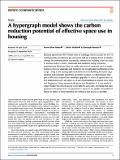A hypergraph model shows the carbon reduction potential of effective space use in housing
Author(s)
Weber, Ramon Elias; Mueller, Caitlin; Reinhart, Christoph
DownloadPublished version (3.311Mb)
Publisher with Creative Commons License
Publisher with Creative Commons License
Creative Commons Attribution
Terms of use
Metadata
Show full item recordAbstract
Humans spend over 90% of their time in buildings, which account for 40% of anthropogenic greenhouse gas emissions and are a leading driver of climate change. Incentivizing more sustainable construction, building codes are used to enforce indoor comfort standards and minimum energy efficiency requirements. However, they currently only reward measures such as equipment or envelope upgrades and disregard the actual spatial configuration and usage. Using a new hypergraph model that encodes building floorplan organization and facilitates automatic geometry creation, we demonstrate that space efficiency outperforms envelope upgrades in terms of operational carbon emissions in 72%, 61% and 33% of surveyed buildings in Zurich, New York, and Singapore. Using automatically generated floorplans in a case study in Zurich further increased access to daylight by up to 24%, revealing that auto-generated floorplans have the potential to improve the quality of residential spaces in terms of environmental performance and access to daylight.
Date issued
2024-09-27Department
Massachusetts Institute of Technology. Building Technology ProgramJournal
Nature Communications
Publisher
Springer Science and Business Media LLC
Citation
Weber, R.E., Mueller, C. & Reinhart, C. A hypergraph model shows the carbon reduction potential of effective space use in housing. Nat Commun 15, 8327 (2024).
Version: Final published version